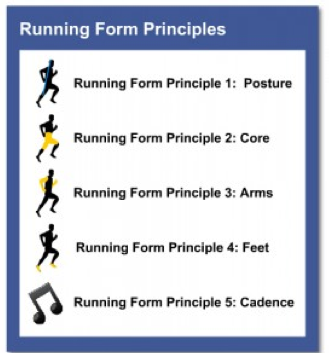 For the past 12 years, I have dissected and modified hundreds of shoes,
taught running form clinics around the country, opened a minimalist store in my
home town of Shepherdstown, West Virginia, directed races (from 5K fun runs to
marathons), got local children excited about running, and most importantly
listened with all my senses –starting with my bare soles. Unless runners
understand the important principles of the gait cycle, or running movement, it
can be difficult to know how to make the personal (and go-it-slow, gradual
adaptation) to natural running. Still, it bears mentioning: natural running is
not a brand or specific method, but rather what humans have done for several million
years. There is no perfect way to run and science will never give us all the answers. The beauty of running is in the play and art of movement.
For the past 12 years, I have dissected and modified hundreds of shoes,
taught running form clinics around the country, opened a minimalist store in my
home town of Shepherdstown, West Virginia, directed races (from 5K fun runs to
marathons), got local children excited about running, and most importantly
listened with all my senses –starting with my bare soles. Unless runners
understand the important principles of the gait cycle, or running movement, it
can be difficult to know how to make the personal (and go-it-slow, gradual
adaptation) to natural running. Still, it bears mentioning: natural running is
not a brand or specific method, but rather what humans have done for several million
years. There is no perfect way to run and science will never give us all the answers. The beauty of running is in the play and art of movement.
The following tips will help you improve and refine your own technique and running form. Although this information might appear technical in a few places, it can be
easily learned by all runners. Finally, the text and graphics originally appeared on Two Rivers Treads under the tab named Dr. Mark’s Running School (additional form photos can be found there.) 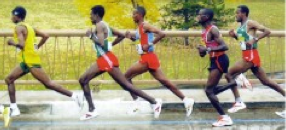 You will also find further information about improving your own running efficiency. Also: check out the other sections right here on the Natural Running Center. The videos can be especially helpful. You might want to start with Principles of Natural Running that was first presented at University of Virginia Running Medicine Conference in 2012, or Barefoot Running Style that was first shown at
the American Medical Association’s Boston Marathon Sports Medicine Symposium in 2011). And thank you to everyone who have left their own comments on both video pages.
You will also find further information about improving your own running efficiency. Also: check out the other sections right here on the Natural Running Center. The videos can be especially helpful. You might want to start with Principles of Natural Running that was first presented at University of Virginia Running Medicine Conference in 2012, or Barefoot Running Style that was first shown at
the American Medical Association’s Boston Marathon Sports Medicine Symposium in 2011). And thank you to everyone who have left their own comments on both video pages.
Finally, some extra words of wisdom from my friend, author and running coach Brian Martin in Australia:
While it’s easy to describe the principles of good natural running technique, it’s much harder to learn them; this is where experiencing different stimuli such as barefoot running, wearing minimalist running shoes, strength training and using specific mental cues to activate your buttocks can help.
Learning any new skill takes time and experimentation, so it’s better to think of it as a cycle rather than a linear progression with a fixed end point. You can always keep learning and evolving; new discoveries feed your progress and inspire new levels of performance, but you must be prepared to try and fail as part of the journey. This is where taking things slowly is all important, as it keeps the magnitude of any failure small –for example, a bit of soreness and a day off running rather than a full-blown injury that keeps you out for months.
***
Running Form Principle 1: (Run Tall) Posture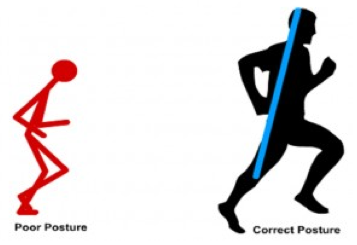
Correct:
• Run tall – imagine your column being stacked under your head
• Look straight ahead to the horizon
• Ball of foot and heel are level on ground
• To move forward lean in like giving a kiss
Wrong:
• Back seat posture
• Bent forward at waist
• Body adjustments to heel lift
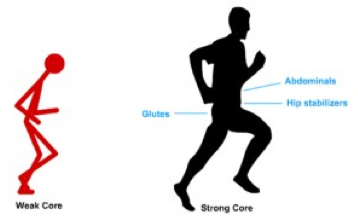 Running Form Principle 2: Strong and Stable Core
Running Form Principle 2: Strong and Stable Core
Correct:
• Core = abdominals, hips, and glutes
• strong and stable while in motion
• proper timing of nerves and muscles (neuromuscular)
• allows optimal energy transfer from the ground
Wrong:
• Back seat
• Head forward
• Hip dip – caused by weak hips
• Side-to-side motion
Running Form Principle 3: Arms and Hands
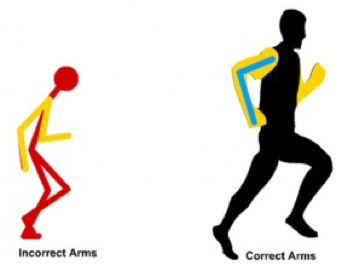 Correct:
Correct:
• arms set rhythm
• elbows at 90 degrees or less
• relaxed rearward drive of elbow
• arms reflexively come forward
• knuckles close to sternum- foot always lands under hand.
Wrong:
• hands should not cross center
• do not pump arms
• arm out in front along with overstriding
Running Form Principle 4: Feet
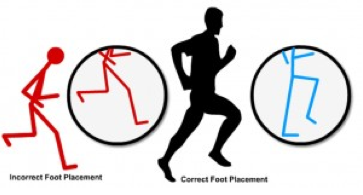 Correct:
Correct:
• Feet land close to center
• Full foot contacts ground
• Balance and rhythm
• Legs store and release energy
• use glutes to get foot down and generate more spring and power
Wrong:
• Overstride forefoot landing–foot stretched out in front
• Forefoot landing without letting heel settle down (running on balls of feet)
• Overstride heel landing
Running Form Principle 5: Cadence and Rhythm
Correct:
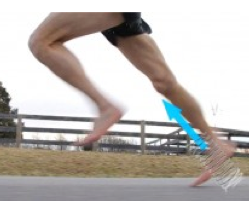 • harness the energy from your springs
• harness the energy from your springs
• Engage the glutes and pop off the ground
• extend hips to propel forward
• cadence 170-180 steps per minute
• Find rhythm that is natural for your springs
Wrong:
• Do not actively lift your leg upward; let it spring
• Slow sticky over-stride pattern. Uses excessive muscle energy.
• Cadence too fast and over-driving spring

Great Tips! Running may be one of the most efficient, accessible ways to stay fit. Running is also wildly popular in USA. And while part of its attraction is that nearly anyone can do it, running is an activity in which small variables can make a big impact over the course of a 2- or 3-mile. I agree that proper running form is very much required, which many runners, particularly newbies ignore. This article will definitely help the beginners. Thanks!